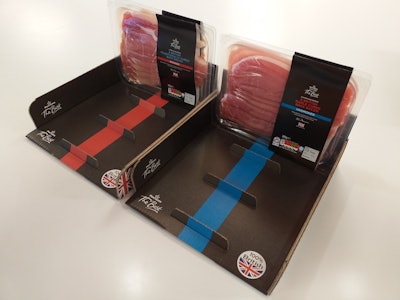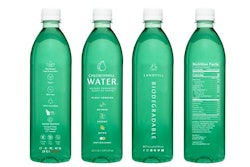Historically, single-use plastic trays have been the retail standard to keep products upright on shelf. Taking positive steps to reduce its use of plastic packaging, Morrisons revised its packaging policy in 2019 to challenge the use of any plastic. In addition, Morrisons wanted to reduce supply chain and material costs and improve the customer experience, aiding navigation for shoppers in-store and improving on-shelf availability in order to increase sales.
DS Smith had simultaneously been exploring a new RRP design using sustainable fiber-based corrugated, which is 100 per cent recyclable. When Morrisons saw the DS Smith Optishop Fin concept, it seemed like the perfect solution, so DS Smith became the development partner for this new package format. It’s a scalable on-shelf pack for supermarket shelves that can be assembled at high speed. The open nature of the new RRP design allows consumers to easily select a preferred primary pack without disrupting the remaining contents.
RRP is traditionally designed to be viewed face on. In contrast, this design has asymmetrical sides so branding can be seen well in advance of reaching the product, giving it additional call out and visual appeal.
The team at Morrisons joined DS Smith colleagues at the Featherstone PackRight Centre, afterwards working collaboratively to conduct multiple lineside trials and due diligence, evolving and refining the design, ready for full scale manufacture. A stainless-steel assembly jig was also designed to achieve packing line efficiencies.
Katherine Whitham, Procurement Manager - Packaging/Manufacturing at Morrisons, explains: “The solution that the DS Smith team devised perfectly fulfilled our Best Bacon re-launch brief. For us, the primary pack is king, and it is vital that the pack remains upright. We are delighted by the visual impact of the RRP and how it complements the product and primary pack. We believe it will create shelf disruption, encourage sales growth and boost market share.”
Another significant element of the RRP is improved shelf utilization and pallet fill, compared to the previous on-shelf packaging. Shelf replenishment time is reduced as there are no perforations to activate and it is simply removed from the transit packaging and placed straight onto the shelf.
Used trays require no knock-down once shopped and are easily compacted back of store ready for recycling. This means the packaging is a real closed-loop initiative, supporting Morrisons’ commitment to a circular economy.


























